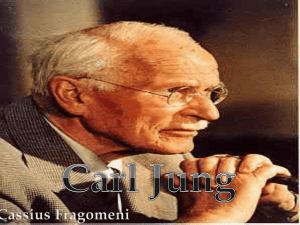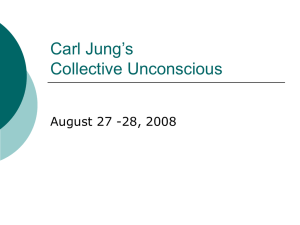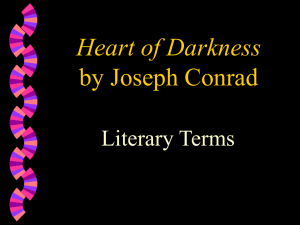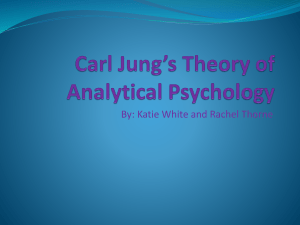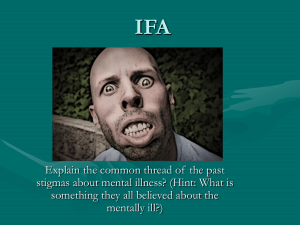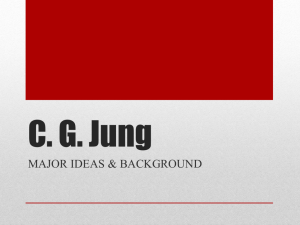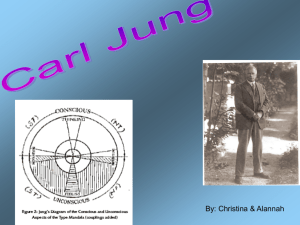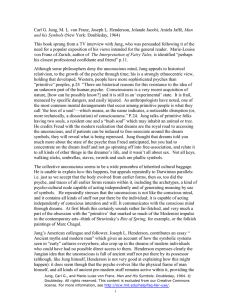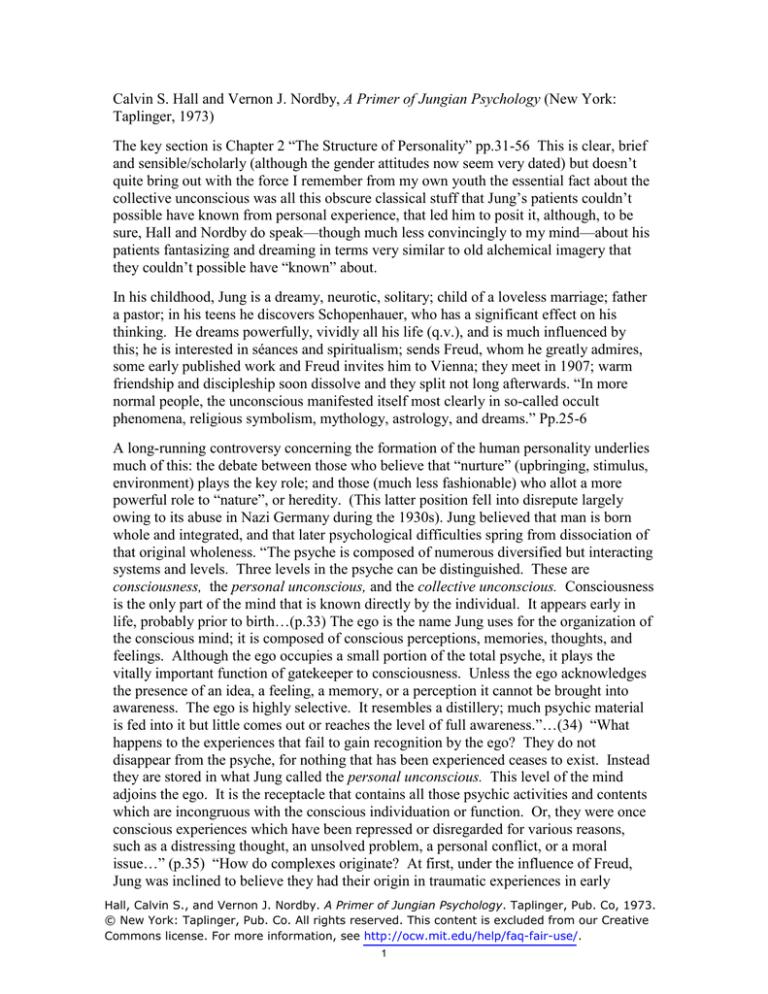
Calvin S. Hall and Vernon J. Nordby, A Primer of Jungian Psychology (New York:
Taplinger, 1973)
The key section is Chapter 2 “The Structure of Personality” pp.31-56 This is clear, brief
and sensible/scholarly (although the gender attitudes now seem very dated) but doesn’t
quite bring out with the force I remember from my own youth the essential fact about the
collective unconscious was all this obscure classical stuff that Jung’s patients couldn’t
possible have known from personal experience, that led him to posit it, although, to be
sure, Hall and Nordby do speak—though much less convincingly to my mind—about his
patients fantasizing and dreaming in terms very similar to old alchemical imagery that
they couldn’t possible have “known” about.
In his childhood, Jung is a dreamy, neurotic, solitary; child of a loveless marriage; father
a pastor; in his teens he discovers Schopenhauer, who has a significant effect on his
thinking. He dreams powerfully, vividly all his life (q.v.), and is much influenced by
this; he is interested in séances and spiritualism; sends Freud, whom he greatly admires,
some early published work and Freud invites him to Vienna; they meet in 1907; warm
friendship and discipleship soon dissolve and they split not long afterwards. “In more
normal people, the unconscious manifested itself most clearly in so-called occult
phenomena, religious symbolism, mythology, astrology, and dreams.” Pp.25-6
A long-running controversy concerning the formation of the human personality underlies
much of this: the debate between those who believe that “nurture” (upbringing, stimulus,
environment) plays the key role; and those (much less fashionable) who allot a more
powerful role to “nature”, or heredity. (This latter position fell into disrepute largely
owing to its abuse in Nazi Germany during the 1930s). Jung believed that man is born
whole and integrated, and that later psychological difficulties spring from dissociation of
that original wholeness. “The psyche is composed of numerous diversified but interacting
systems and levels. Three levels in the psyche can be distinguished. These are
consciousness, the personal unconscious, and the collective unconscious. Consciousness
is the only part of the mind that is known directly by the individual. It appears early in
life, probably prior to birth…(p.33) The ego is the name Jung uses for the organization of
the conscious mind; it is composed of conscious perceptions, memories, thoughts, and
feelings. Although the ego occupies a small portion of the total psyche, it plays the
vitally important function of gatekeeper to consciousness. Unless the ego acknowledges
the presence of an idea, a feeling, a memory, or a perception it cannot be brought into
awareness. The ego is highly selective. It resembles a distillery; much psychic material
is fed into it but little comes out or reaches the level of full awareness.”…(34) “What
happens to the experiences that fail to gain recognition by the ego? They do not
disappear from the psyche, for nothing that has been experienced ceases to exist. Instead
they are stored in what Jung called the personal unconscious. This level of the mind
adjoins the ego. It is the receptacle that contains all those psychic activities and contents
which are incongruous with the conscious individuation or function. Or, they were once
conscious experiences which have been repressed or disregarded for various reasons,
such as a distressing thought, an unsolved problem, a personal conflict, or a moral
issue…” (p.35) “How do complexes originate? At first, under the influence of Freud,
Jung was inclined to believe they had their origin in traumatic experiences in early
Hall, Calvin S., and Vernon J. Nordby. $3ULPHURI-XQJLDQ3V\FKRORJ\. Taplinger, Pub. Co, 1973.
© New York: Taplinger, Pub. Co. All rights reserved. This content is excluded from our Creative
Commons license. For more information, see http://ocw.mit.edu/help/faq-fair-use/.
1
childhood. For example, a child might be abruptly separated from his mother, which
could give rise to an enduring mother-complex as a compensation for the lost mother.
Jung was not to be satisfied with this explanation for very long. He came to the
realization that complexes must originate out of something much deeper in human nature
than early childhood experiences. Prompted by curiosity over what this deeper something
might be, Jung discovered another level of the psyche, which he called the collective
unconscious…” (p.38) [the section on the collective unconscious occupies pp.38-41, and
the following section on archetypes, pp.39-43] “Both the conscious mind and the
unconscious mind were seen, for the most part, as originating out of experience.
Repression of traumatic childhood experiences formed the unconscious, according to
Freud, although he was to modify this view later…In any event, it was Jung who broke
free from a strictly environmental determinism of the mind, and showed that evolution
and heredity provide the blue-prints of the psyche just as they provide the blueprints of
the body. The discovery of the collective unconscious was a landmark in the history of
psychology.
The mind, through its physical counterpart, the brain, has inherited characteristics what
determine the ways in which a person will react to life’s experiences and even determine
what type of experiences he will have. The mind of man is prefigured by evolution.
Thus, the individual is linked with his past, not only with the past of his infancy but more
importantly with the past of the species and before that with the long stretch of organic
evolution. This placing of the psyche within the evolutionary process was Jung’s
preeminent achievement…First of all, it is that portion of the psyche which can be
differentiated from the personal unconscious by the fact that its existence is not
dependent upon personal experience The personal unconscious is composed of contents
that were once conscious, but the contents of the collective unconscious have never been
conscious, within the lifetime of the individual.
The collective unconscious is a reservoir of latent images, usually called primordial
images by Jung…Man inherits these images from his ancestral past, a past that includes
all of his human ancestors as well as his prehuman or animal ancestors These racial
images are not inherited in the sense that a person consciously remembers or has images
that his ancestors had. Rather they are predispositions or potentialities for experiencing
and responding to the world in the same ways that his ancestors did…(p.39)” They point
out that unfortunately this is a Lamarckian view (a reference to the famous French thinker
Jean-Baptist Lamarck who argued for the transmissibility of acquired characteristics) but
that one can also explain the collective unconscious in orthodox Darwinian terms.
Jung posited numerous archetypes, including “birth, rebirth, death, power, magic, the
hero, the child, the trickster, God, the demon, the wise old man, the earth mother, the
giant, many natural objects like trees, the sun, the moon, wind, rivers, fire and animals,
and many man-made objects such as rings and weapons.” (pp.41-2) These are
predispositions merely, he insisted, to be fleshed out in contact with direct experience by
each individual. “Although archetypes are separate structures in the collective
unconscious they can form combinations. For example, if the hero archetype combines
with the demon archetype, the result could be a ‘ruthless leader’ type of person…Since
the archetypes are capable of interacting with each other in various combinations, this
Hall, Calvin S., and Vernon J. Nordby. $3ULPHURI-XQJLDQ3V\FKRORJ\. Taplinger, Pub. Co, 1973.
© New York: Taplinger, Pub. Co. All rights reserved. This content is excluded from our Creative
Commons license. For more information, see http://ocw.mit.edu/help/faq-fair-use/.
2
also becomes a factor in producing personality differences among individuals.” P.42.
Archetypes are universal, but this still leaves wide room for individual and cultural
difference in the fleshing out of an archetype such as “mother”.
“…it is, in fact, the nucleus of a complex. The archetype, acting as a center or nucleus,
functions as a magnet, attracting relevant experiences to it to form a complex. After
gaining sufficient strength from the addition of experiences, the complex can penetrate
into consciousness. It is only by being the center of a well-developed complex that the
archetype can find expression in consciousness and behavior.” P.43 Then we get
discussion of Persona [the constructed social mask], Anima/Animus. The Shadow and the
Self are treated as archetypes. The Shadow is the animalistic, destructive, dark Jungian
equivalent to the Id. Jung considered it, on the other hand, the source of all intuitive
creativity. It seems to be being used here in a sense close to “instinct.” Although its
promptings can be thrust temporarily into the unconscious, it never gives up.
Archetypes express themselves in symbols and in a process which Jung called
“amplification” (very similar to the horizon-of-expectation type general-contextual
approach we see in the Constance School) may be expounded and interpreted. It’s very
like lit. crit. of the more ambitious and expansive sort.
Here’s a good bit from Jung himself, writing in 1948 (collected works, 9i, p.253, quoted
here on pp;.129-30): “What have all our cultural achievements led to? The fearful
answer is there before our eyes: we have been delivered from no fear, a hideous
nightmare lies upon the world. So far reason has failed lamentably, and the very thing
that everybody wanted to avoid rolls on in ghastly progression. Man has achieved a
wealth of useful gadgets, but, to offset that, he has torn open the abyss, and what will
become of him now—where can he make a halt? After the last World War we hoped for
reason; we go on hoping. But already we are fascinated by the possibilities of atomic
fission and promise ourselves a Golden Age-the surest guarantee that the abomination of
desolation will grow to limitless dimensions. And who or what it is that causes all this?
It is none other than that harmless (!), ingenious, inventive, and sweetly reasonable
human spirit who unfortunately is abysmally unconscious of the demonism that still
clings to him. Worse, this spirit does everything to avoid looking himself in the face, and
we all help him like mad. Only, heaven preserve us from psychology—that depravity
might lead to self-knowledge! Rather let us have wars, for which somebody else is
always to blame, nobody seeing that all the world is driven to do just what all the world
flees from in terror.”
Hall, Calvin S., and Vernon J. Nordby. $3ULPHURI-XQJLDQ3V\FKRORJ\. Taplinger, Pub. Co, 1973.
© New York: Taplinger, Pub. Co. All rights reserved. This content is excluded from our Creative
Commons license. For more information, see http://ocw.mit.edu/help/faq-fair-use/.
3
MIT OpenCourseWare
http://ocw.mit.edu
21L.430 / CMS.920 Popular Culture and Narrative: Use and Abuse of the Fairy Tale
Fall 2015
For information about citing these materials or our Terms of Use, visit: http://ocw.mit.edu/terms.

